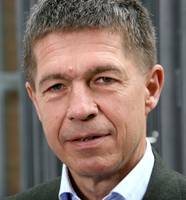Joachim Sauer receives the Visiting Miller Professorship of the University of California Berkeley. He will stay with Daniel Neumark during August/September 2013. Within UniCat, Joachim Sauer is Coordinator of Research Area D1.
Jochim Sauer
Joachim Sauer received the Dr. rer. nat. degree in Chemistry from Humboldt University in Berlin in 1974, and the Dr. sc. nat. degree from the Academy of Sciences in (East-)Berlin in 1985. Since 1993 he is Professor of Theoretical Chemistry at the Humboldt University in Berlin, and since 2006 external member of the Fritz Haber Institute (Max Planck Society). He is member of the Berlin-Brandenburg (formerly Prussian) Academy of Sciences, the German National Academy Leopoldina, and the Academia Europaea.
His research has explored the application of quantum chemical methods in chemistry, with emphasis on surface science, particularly adsorption and catalysis.
He has published more than 300 research papers, notably in the area of modeling the structure and reactivity of zeolites and transition metal oxide catalysts, and he has given more than 330 invited lectures. From 1999 to 2011 he was chairman of the Collaborative Research Center of the German Research Foundation (DFG) "Aggregates of transition metal oxides - Structure, dynamics, reactivity" and he is co-founder and principal investigator of the DFG-funded Cluster of Excellence UniCat in Berlin. In his research, Joachim Sauer uses quantum chemical and other computational tools to find out how solid catalysts work.
The Miller Fellow Program of University of California Berkeley
The Miller Fellow program is the central program of the Adolph C. and Mary Sprague Miller Institute for Basic Research in Science on the University of California Berkeley campus, which constitutes the support of Research Fellows and Miller Visiting Professorships.
The Visiting Miller Professorship Award and Gabor A. Somorjai
The Visiting Miller Professorship Award was established through a major gift to the Institute by Gabor A. and Judith K. Somorjai. The Somorjai's wishes are to support early career visiting scientists for a one-month term in the Miller Institute. Eligible recipients will be selected through the established Visiting Miller Professorship program competition and priority consideration will be granted to visiting scientists within the broad field of chemical sciences.
Gabor Somorjai is a Professor of Chemistry at the University of California, Berkeley and a Faculty Senior Scientist at the Lawrence Berkeley National Laboratory. He was born in Budapest in 1935. While attending University in the 1950s he met the young Judith Kaldor, his future wife, with whom he fled abroad after the Soviet suppression of the Hungarian Revolution.
He received a PhD in Physical Chemistry at UC Berkeley in 1960 and then moved to New York to work at IBM in Yorktown Heights before returning to Berkeley to begin his academic career in 1964. He received tenure three years later and was appointed Full Professor in 1972. In 2001 he was named University Professor, the highest honor for faculty within the UC System.
Professor Somorjai has trained more than 130 PhD students and 200 post-doctoral fellows. He has hosted Visiting Miller Professors Mostafa El-Sayed, Rutger Van Santen, Martin Quack, Ivar Olovsson, David King, John Pendry, Hans Siegmann, John Simons, and Harald Ibach and Miller Fellow Bruce Koel.
Professor Somorjai's research has focused on exploring and understanding catalytic selectivity of transition metal surfaces on the molecular level. His novel approach is to use model systems, presently monodispersed nanoparticles in the 1-10 nm range, to explore hydrocarbon conversion reactions. An important discovery from these studies is that the size and shape of metal nanoparticles control both reaction rates and selectivities. He developed surface-sensitive instruments that have permitted molecular level studies of the catalysts under reaction conditions at high pressures. Before the advent of these applications most catalysts were characterized only before and after the reactions. Somorjai has helped catalytic chemistry in its epoch-making transition from the macroscopic view to molecular-scale analysis.

